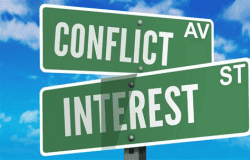A policy for a company’s conflict of interest should answer these questions: What is a conflict of interest? How do I protect my business from it? And how can I ensure that I am following the rules? The first step is to create a policy. The policy should include basic information and answer common questions. Here are some examples: A board member’s salary is paid by a nonprofit; an employee’s relationship with a higher authority creates a conflict of interests.
A conflict of interest is when a person has two or more competing interests. It is a situation where one person’s self-interest is in conflict with another’s. For example, an employee may want to take a bribe from a company that produces inferior goods. A conflict of interest can also occur if a person serves two groups, such as a doctor accepting gifts from a pharmaceutical company to supply drugs that might not be the best for the patient. In this scenario, a person’s self-interest is in direct opposition to the interests of the other party.
Conflicts of interest can arise from personal business interests. For example, a person who works for two businesses in the same industry is considered to have a conflict of interest. Public servants may have a conflict of interest if they work for the government and who have personal or family involvement in supplying government contracts. Other conflicts of interest can arise from being on the board of a third company, owning stock in a fourth, or being a board member of another company. Whether the conflict is a private or public interest, the employee’s personal interest should be clearly understood.
A conflict of interest can occur when a person’s professional interests and personal interests are in direct conflict. While it is never illegal to pursue a private interest, it is unwise to combine a personal and professional interest to achieve a professional end. For legal guidance on such matters, consider Ascot solicitors like www.parachutelaw.co.uk
Basically, a conflict of interest is a situation where a person’s primary and secondary interests are in direct conflict. The conflict is an inherent problem and is a sign that the individual’s professional actions are in conflict with their personal interests. It may be a sign that an employee has ulterior motives that are not aligned with the public good, for example. Nepotism is another example of a conflict of interest, where someone favours familial connections in business.
A conflict of interest is when a person’s private interests conflict with his or her official interests. An employee may have financial or personal interests that are in direct competition with the company they work for. An employee may have an interest in a company that isn’t in the same business as the employer but is in the same industry. A person’s private interest can affect his or her job performance.



